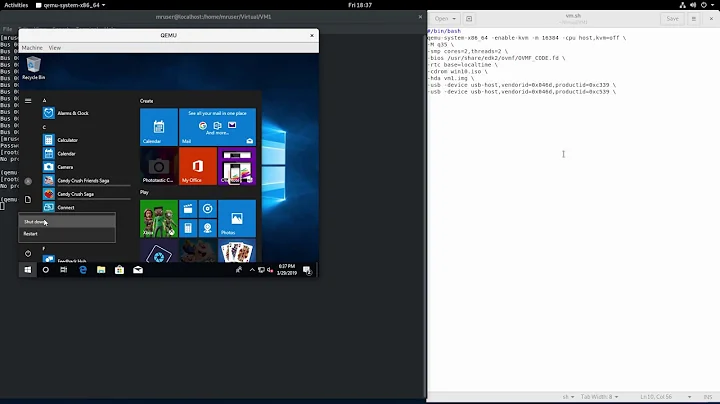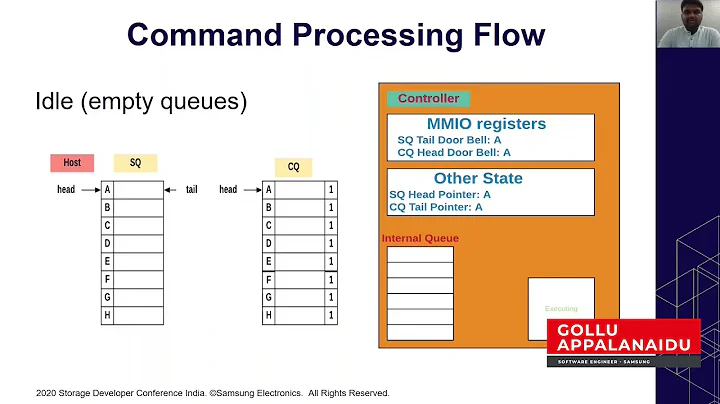How can I simulate USB storage device connection with qemu?
I found the solution here: USB emulation
3.11 USB emulation
QEMU emulates a PCI UHCI USB controller. You can virtually plug virtual USB devices or real host USB devices (experimental, works only on Linux hosts). QEMU will automatically create and connect virtual USB hubs as necessary to connect multiple USB devices.
3.11.1 Connecting USB devices
USB devices can be connected with the -usbdevice commandline option or the usb_add monitor command. Available devices are:
mouseVirtual Mouse. This will override the PS/2 mouse emulation when activated.
tabletPointer device that uses absolute coordinates (like a touchscreen). This means QEMU is able to report the mouse position without having to grab the mouse. Also overrides the PS/2 mouse emulation when activated.
disk:fileMass storage device based on file (see disk_images)
host:bus.addrPass through the host device identified by bus.addr (Linux only)
host:vendor_id:product_idPass through the host device identified by vendor_id:product_id (Linux only)
wacom-tabletVirtual Wacom PenPartner tablet. This device is similar to the tablet above but it can be used with the tslib library because in addition to touch coordinates it reports touch pressure.
keyboardStandard USB keyboard. Will override the PS/2 keyboard (if present).
serial:[vendorid=vendor_id][,product_id=product_id]:devSerial converter. This emulates an FTDI FT232BM chip connected to host character device dev. The available character devices are the same as for the -serial option. The vendorid and productid options can be used to override the default 0403:6001. For instance,
usb_add serial:productid=FA00:tcp:192.168.0.2:4444will connect to tcp port 4444 of ip 192.168.0.2, and plug that to the virtual serial converter, faking a Matrix Orbital LCD Display (USB ID 0403:FA00).
brailleBraille device. This will use BrlAPI to display the braille output on a real or fake device.
net:optionsNetwork adapter that supports CDC ethernet and RNDIS protocols. options specifies NIC options as with -net nic,options (see description). For instance, user-mode networking can be used with
qemu-system-i386 [...OPTIONS...] -net user,vlan=0 -usbdevice net:vlan=0Currently this cannot be used in machines that support PCI NICs.
bt[:hci-type]Bluetooth dongle whose type is specified in the same format as with the -bt hci option, see allowed HCI types. If no type is given, the HCI logic corresponds to -bt hci,vlan=0. This USB device implements the USB Transport Layer of HCI. Example usage:
qemu-system-i386[...OPTIONS...] -usbdevice bt:hci,vlan=3 -bt device:keyboard,vlan=3
Related videos on Youtube
Raydel Miranda
Updated on September 18, 2022Comments
-
 Raydel Miranda over 1 year
Raydel Miranda over 1 yearI'm writing a program for controlling USB storage device connections (this is a classic subject). All it's ok with my program, but now, I want to write some tests. So in order to do that, I realized I'll need some way of simulate USB connections.
And not only the connections, I need to be able to set the device properties: capacity, format, etc...
-
 Admin about 10 yearswhat has the USB simulation to do with qemu?
Admin about 10 yearswhat has the USB simulation to do with qemu? -
 Admin about 10 yearsWell... I saw into
Admin about 10 yearsWell... I saw intosystemdcode (freedesktop.org/wiki/Software/systemd) that they usit for tests onudev. I then make the conclusion that they must be usingqemuto simulate some "hardware thigns." -
 Admin about 10 yearsHow ever if you know other way for doing that, I'll thank you point me the right direction.
Admin about 10 yearsHow ever if you know other way for doing that, I'll thank you point me the right direction. -
 Admin about 10 yearswell, qemu/kvm is good for testing. in case of a failure you don't need to reboot. Special usb hardware needs to be forwarded to qemu/kvm with
Admin about 10 yearswell, qemu/kvm is good for testing. in case of a failure you don't need to reboot. Special usb hardware needs to be forwarded to qemu/kvm withusb_add. I am not up to date with the latest dev, so I can't tell you.
-




